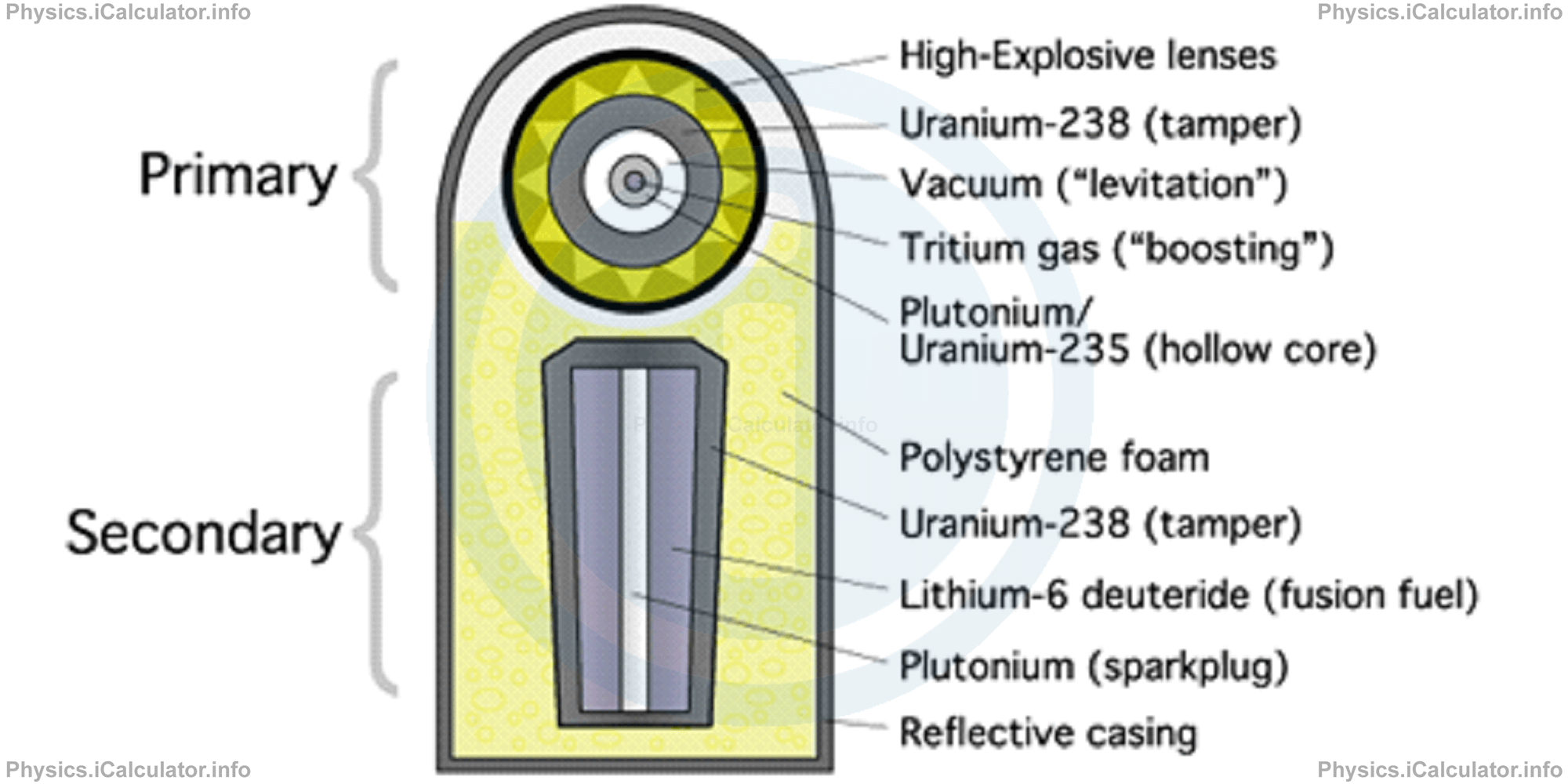Menu
Physics Lesson 20.4.10 - Application in Practice of Nuclear Fusion Reactions
Please provide a rating, it takes seconds and helps us to keep this resource free for all to use
Welcome to our Physics lesson on Application in Practice of Nuclear Fusion Reactions, this is the tenth lesson of our suite of physics lessons covering the topic of Nuclear Reactions, you can find links to the other lessons within this tutorial and access additional physics learning resources below this lesson.
Application in Practice of Nuclear Fusion Reactions
In the following paragraphs of this article, we will provide some examples of application in practice of nuclear fusion reactions.
a. Hydrogen bomb
This bomb consists of two main parts: nuclear bomb, which produces the neutrons needed for the transformation of lithium into tritium and at the same time, it brings the system at high temperature, as needed for enabling the fusion reaction. This is the primary bomb. There is also a second part (secondary bomb), which consists of a mixture of lithium and deuterium. Neutrons produce tritium and helium according the above reaction. The figure below shows a scheme of hydrogen (thermonuclear) bomb.

Despite the hydrogen bomb being clean in itself (although it causes harm in living organisms and structural damage in the surrounding objects due to high explosive power), there is some radioactive pollution caused by the incorporated nuclear bomb that provides the initial ignition (nuclear bombs use uranium as primary source of energy).
b. Neutron bomb
This bomb makes use of fast neutrons emitted during a fusion reaction. The energy of these neutrons is able to seriously harm living organisms and cause their death. Neutron bombs are not environment pollutants as they are not radioactive. Likewise, neutron bombs do not cause harm to building structures.
c. Neutron Generators
In some cases, the technology used in neutron bombs can be used to generate new neutrons needed for nuclear reactions. However, to avoid radioactive pollution, an electric field is used instead of radioactive material to accelerate the nuclei in order to obtain fast neutrons. This electric field is obtained by creating a potential difference of several hundreds of kilovolts. After gaining enough speed, the nuclei hit a target enriched with tritium. At this point, nuclear fusion takes place - a process which results in generation of fast neutrons that can eventually be used for various purposes.
d. Energy production
As explained earlier, energy is another product of nuclear reactions besides the changes in the structure of matter involved in the process. This energy turns into heat during the deceleration of fast neutrons. The high temperature achieved during this process brings a continuity in the process resulting in a sustainable source of energy.
This technology however, bears two issues: (1) how to keep the deuterium and tritium enclosed in fixed containers in such high temperatures by avoiding explosion, and (2) how to extract the extra energy form there, in order to convert it into other forms of energy. In other words, how to keep under control a thermonuclear reaction? This is still an unaddressed issue despite the huge advancements in technology. If scientist are able to find a way to overcome these drawbacks in the future, then the issue of energy production will be definitively addressed.
Currently, we use a small portion of thermonuclear energy produced naturally in the Sun. The good news in this regard is that we are too far to be affected by the harmful effects of such non-controllable thermonuclear fusion processes.
You have reached the end of Physics lesson 20.4.10 Application in Practice of Nuclear Fusion Reactions. There are 11 lessons in this physics tutorial covering Nuclear Reactions, you can access all the lessons from this tutorial below.
More Nuclear Reactions Lessons and Learning Resources
Whats next?
Enjoy the "Application in Practice of Nuclear Fusion Reactions" physics lesson? People who liked the "Nuclear Reactions lesson found the following resources useful:
- Applications Feedback. Helps other - Leave a rating for this applications (see below)
- Nuclear Physics Physics tutorial: Nuclear Reactions. Read the Nuclear Reactions physics tutorial and build your physics knowledge of Nuclear Physics
- Nuclear Physics Revision Notes: Nuclear Reactions. Print the notes so you can revise the key points covered in the physics tutorial for Nuclear Reactions
- Nuclear Physics Practice Questions: Nuclear Reactions. Test and improve your knowledge of Nuclear Reactions with example questins and answers
- Check your calculations for Nuclear Physics questions with our excellent Nuclear Physics calculators which contain full equations and calculations clearly displayed line by line. See the Nuclear Physics Calculators by iCalculator™ below.
- Continuing learning nuclear physics - read our next physics tutorial: Atomic Nucleus and Its Structural Properties
Help others Learning Physics just like you
Please provide a rating, it takes seconds and helps us to keep this resource free for all to use
We hope you found this Physics lesson "Nuclear Reactions" useful. If you did it would be great if you could spare the time to rate this physics lesson (simply click on the number of stars that match your assessment of this physics learning aide) and/or share on social media, this helps us identify popular tutorials and calculators and expand our free learning resources to support our users around the world have free access to expand their knowledge of physics and other disciplines.